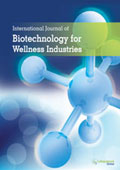ijbwi
Abstract : Stress Induced Lipids Accumulation in Naviculoid Marine Diatoms for Bioenergy Application
|
|
Abstract: Microalgae are expected to play promising role in the production of biofuel in current research. Two of marine diatoms, Navicula sp. and Amphora sp. were isolated and their growth rate was also studied. Total lipid content was analyzed in stationary growth state under normal conditions. By the two stage process, both the diatoms were subjected to nitrogen and silicon undersupplied for five days and the total lipid accumulation in the diatoms were found to be increased during nutrient deficiency period. The nutrient deficit conditions prone to increased total lipid content and also altered the fatty acid profile in diatom. The total lipid content of Navicula sp. and Amphora sp. were found to be 34.93% DCW and 41.10% DCW under normal conditions and in nitrogen deficiency conditions it has been increased to 60.71% DCW and 64.72% DCW respectively. The major fatty acids were found to be cis-10-Heptadecanoic acid (27.54%) and stearic acid (24.57%). The level of saturated and monounsaturated fatty acids were found to be high in both the diatoms. The presence of low level of polyunsaturated fatty acids indicated that these two organisms could find future application in bioenergy production. Keywords: Biodiesel, Fatty acid, Navicula sp., Amphora sp., Nitrogen and silicon starvation.Download Full Article |
Abstract : Reversing Breast Cancer in a Premenopausal Woman: A Case for Phyto-Nutritional Therapy
|
|
Abstract: Globally, breast cancer incidence increases at 1% to 2% annually. It is the number one cause of cancer death in women. Current literature implies that soy food intake is linked to decreased risk of breast cancer due to its rich isoflavones. On the other hand, intake of animal fat, red meat, organ meat and high-fat dairy products during premenopausal years may increase risk for this cancer, but no apparent risk has been established for fish or poultry intake. Monounsaturated fat and the improved ratio of omega-3 to omega-6 fatty acids have showed potential to reduce risk. On the other hand, high glycemic index diet but not glycemic load is associated with a significantly increased risk. Central rather than general obesity carries similar risk. Furthermore, lifestyle rather than genetic differences are widely implicated in breast cancer. A comprehensive phyto-nutritional therapy was adopted for treating a case involving stage IV breast cancer in a premenopausal woman, who was turned away by a hospital offering conventional treatment. The therapy involved designing and monitoring the implementation of dietary plans to achieve optimum health outcomes for the major abnormal metabolic blood/urine markers identified for this particular patient. Nutrient-dense food items with generous servings of a variety of spices and herbs, supplemented by vitamins, minerals and phyto-extracts was prescribed as part of the therapy. Many non-toxic dietary nutrients and phytonutrients are known cytotoxic agents promoting cancer regression via apoptosis pathways, which have yet to be fully understood. Conclusion: The complete remission of the malignancy initiated by this natural therapy would suggest that an advanced stage breast cancer is a metabolic disorder reversible by an evidence-based phyto-nutritional therapy. While not all cases of malignancy can possibly be completely reversed, the positive outcome achieved in partnership with the patient warrants further study involving larger number of women with similar level of malignancy. Keywords: Breast cancer, nutritional therapy, dietary modification, nutraceuticals, apoptosis.Download Full Article |
Abstract : Biospecific Affinity Chromatography: Computational Modelling via Lattice Boltzmann Method and Influence of Lattice-Based Dimensionless Parameters
|
|
Abstract: Based on a dynamic (i.e. time-dependent) one-dimensional approach, this work applied lattice Boltzmann method (LBM) to computationally model biospecific affinity chromatography (BAC). With governing equations expressed in lattice-based dimensionless form, LBM was implemented in D1Q2 lattice by assigning particle distribution functions to adsorbate concentration in both fluid and solid phases. The LBM simulator was firstly tested in view of a classic BAC work on lysozyme and the streaming step relating to adsorbate concentration in the solid-phase was suppressed from the LBM code with no loss of functionality. Expected behaviour of breakthrough curves was numerically reproduced and the influence of lattice-based dimensionless parameters was examined. The LBM simulator was next applied so as to assess lattice-based dimensionless parameters regarding an experimental BAC work on lipase. Keywords: Biospecific affinity chromatography, phenomenological modelling, numerical simulation, lattice Boltzmann method.Download Full Article |
Abstract : Health and Wellness Product from Mangosteen (Garcinia mangostana L.) Rind: Bioactive Potentials
|
|
Abstract: Mangosteen rind (MSR) (Garcinia mangostana L.) is a predominant component of the fruit contributing to 62% of the whole fruit. However, utilization of the same for the preparation of health products was not explored due to its sensorially less acceptable parameters. Differential extraction in different polarity solvents of MSR was done and evaluated their acceptability for product preparation.Current study thus is a detailed investigation on bioactivity profiling of MSR fraction and utilization of the same for health product preparation. Among various extracts, 70% ethanol (70%AE) yielded the maximum (15g/100g). Xanthone:Phenolic ratio was 1: 2.8, in 70%AE as opposed to hot water extract – HWE and 50% AE, which contained Xanthone:Phenolic ratio of 1:1.4/5. Higher the phenolic content obviously reduces the bitterness of Xanthones. 70% AE contained phenolics 60.08± 0.213 mg/g and xanthones 22.56± 0.317 mg/g. HPLC analysis revealed a spectrum of phenolic acids such as gallic, chlorogenic, caffeic, epicatechin, catechin and ferulic acids at various levels. Potent Free Radical Scavenging (FRS) activity, cytoprotectivity, DNA protectivity, H+K+ATPase inhibitory (PPAI) activities were observed in 70% AE. Gallic/tannic acid appear to contribute to antioxidant activity; while ferulic acid was responsible for PPAI activity in 70%AE. Among xanthones, although α- mangostin was the dominating component, gartanin, 8 deoxygartanin and 3-isomangostin contributed to FRS activity. The products were prepared from 70%AE which are sensorially acceptable. Data thus for the first time delineate the specific health beneficial role of both phenolic and xanthone constituents in MSR particularly with higher abundance of phenolics than xanthones. Keywords: Phenolic, Xanthone, Garcinia mangostana L., Free Radical Scavenging, Cyto/DNA.Download Full Article |























